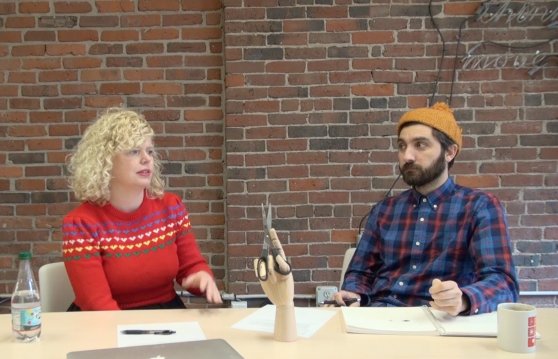We sat down with creative director Erin King and senior art director Brett Saiia to share what it’s like being an art director here — and how the role is different here from what it is at some other companies.
One of the big differentiators is the importance of story. Says Erin, “We’re helping people tell stories, real human stories, not just brand stories. We’re not working with brand managers. It’s awesome because we get to help real people think differently and tell their stories in a new and engaging way. We help our clients think in a more holistic way about what they’d like to share. We go through an artistic and creative process with that person to make their story better.”
“Sometimes we get to go places with a client that are more vulnerable,” Brett says. “It can be scary to the client, but the reward is a much more meaningful story worth sharing. And sometimes people are surprised that they have an interesting story to tell.”
“Whether we’re working on an executive presentation or a tradeshow or a video or any of the many types of materials we create for out clients, something happens when people go from thinking presentation to telling a story,” Erin says. “What emerges is so much more interesting. We get to be on that path with that person. We’re not helping them do bullet points. We’re helping them tell a story. If you’re going onstage to share a personal story, it’s very powerful to know you’ve got us, our coaching, and our visuals behind you. A huge part of what we do is play a support role. At Collective Next, we’re not the ego. We’re here to let our clients come alive.”
That’s another big differentiator here at Collective Next: collaboration, both with the client and one another. “We’re very serious about our work here,” Brett says, “but some of what it’s like to work together here is ridiculous. When you work closely together with people here for a long time, you become a weird family. We’ve worked in each others kitchens, we’ve worked in people’s houses during the Super Bowl. We’re at the point where we can easily finish each other’s work if one of us gets called to something else.”
“It’s like we’re collaborating even when we’re not working together,” Erin says. “You may not show up tomorrow for some reason and someone else will be able to pick it up. We almost never do anything alone.”
That sort of trusting collaboration comes from working together for a long time — Erin and Brett have been working together for 13 years, even before Collective Next. So how does someone new get to be part of that? “They see how we work together, how we learn together, and we have conversations about it while it’s happening.”
“All our work is very iterative,” Brett says. “We don’t just pitch and then go away to vacuum while someone else executes. We are constantly getting and giving feedback.”
Erin calls Collective Next “an incredibly supportive environment. When new people come in, they see we’re not just winging it. We have a practice. It lets us make something awesome. And when something isn’t perfect, we give feedback honestly and openly everyday. Artists know that critique is not criticism. It’s a conversation. The only thing people have ego about here is their spot on the Ms. Pac-Man leaderboard. If you want to succeed here, you really you have to want to learn new things. You have to want to work in a learning environment.”
Erin and Brett agree that one of the best parts of working here is the environment, but Brett says, “an open office isn’t for everyone. Some people want to be freelancers, be at home, work on their computer, and not be bothered. But we like it that everyone is here. It helps us get things done faster and usually better. We do turn things around quickly here, and there’s a tension between what an artist might consider great work and what work is right for the client. In most cases, we don’t have six months to do a project. We have three weeks. We’d like to make every design the most beautiful thing ever — and we do get better at making things beautiful in a condensed timeframe — but that’s another example of how the work here isn’t about you. It’s about helping our clients tell better stories.”

Back




